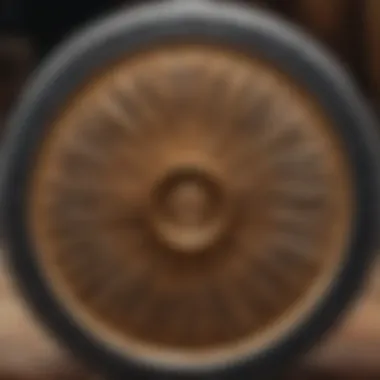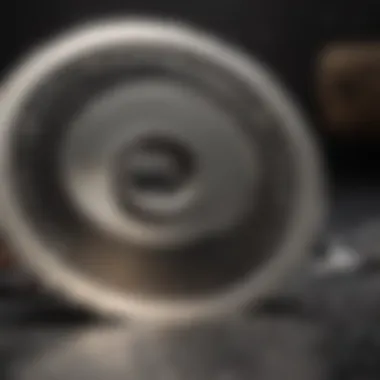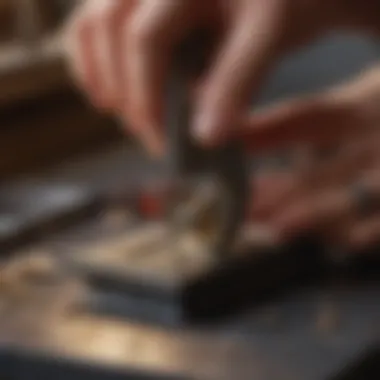Unlocking the Finest Saws for Crafting Exquisite Jewelry


Rock and Fossil Identification
In the realm of jewelry making, understanding the tools of the trade is paramount. One such essential tool is the saw, playing a crucial role in shaping and sculpting intricate designs. For enthusiasts and seasoned professionals immersed in the craft, the choice of the right saw can significantly impact the precision and finesse of the final piece. Delving into the world of jewelry making unveils a plethora of saw types tailored to different purposes, each with distinct features that cater to specific needs and preferences.
Introduction
In the realm of jewelry making, precision and finesse are paramount. One crucial tool that stands out in this craft is the saw. Beyond its seemingly simple functionality lies a tool that can make or break the intricate process of jewelry design. Saws in jewelry making are not mere cutting instruments but delicate instruments that allow artisans to bring their artistic visions to life with immaculate detail and precision.
Understanding the Importance of Saws in Jewelry Making
The importance of saws in jewelry making cannot be overstated. These tools are the unsung heroes behind the intricate filigree work, delicate piercing, and precise cutting that form the backbone of each jewelry piece. Imagine trying to create intricate designs or cut intricate patterns on metal without the aid of a saw – the task would be next to impossible, if not entirely unachievable. Saws for jewelry making provide jewelers with the ability to execute detailed designs, achieve intricate shapes, and bring their creative visions to fruition with a level of detail that surpasses other cutting tools.
Whether it's slicing through metal sheets or delicately cutting intricate patterns, the right saw can make all the difference in the final outcome of a jewelry piece. Precision, control, and accuracy are the hallmarks of a good saw in jewelry making, enabling artisans to transform raw materials into exquisite wearable art. Understanding the nuances of saws, from blade types to ergonomic designs, is essential for any jeweler looking to elevate their craft and produce top-tier creations.
Saws in jewelry making are not just tools; they are extensions of the artisan's creativity, allowing for a seamless transition from design concept to tangible masterpiece. Mastering the art of sawing is a skill that sets skilled jewelers apart, enabling them to push the boundaries of traditional craftsmanship and create unique pieces that showcase their mastery of the craft.
Types of Saws
In the intricate world of jewelry making, the selection of the right saw plays a pivotal role in shaping the final masterpiece. Exploring the various types of saws available provides artisans with the tools necessary to cut and shape their designs with precision and finesse. Understanding the unique features and benefits of each type of saw ensures that craftsmen can elevate their craft to new heights, producing jewelry that is both aesthetically pleasing and structurally sound.
Jeweler's Saw


Types of Blades for Jeweler's Saw
When delving into the realm of jeweler's saws, the choice of blades takes center stage in determining the efficiency and accuracy of cuts made. Selecting the appropriate blade for a jeweler's saw is crucial in achieving clean and intricate cuts on various materials used in jewelry making, whether it be metal, wood, or acrylic. Different blade types cater to specific materials and thicknesses, allowing craftsmen to work with precision and ease, enhancing the overall quality of their creations.
Recommended Brands for Jeweler's Saw
Choosing the right brand for a jeweler's saw can significantly impact the performance and longevity of the tool. Trusted brands in the industry offer reliability, durability, and precision, essential qualities for jewelry makers aiming to achieve impeccable results. Selecting a reputable brand ensures that craftsmen can work efficiently and comfortably, knowing that their tools are of top-notch quality, contributing to the seamless execution of their artistic visions.
Miniature Table Saw
Features to Look for in a Miniature Table Saw
In the realm of miniature table saws, specific features play a crucial role in enhancing the cutting experience for jewelry makers. Features such as blade size, motor power, cutting depth, and safety mechanisms are vital considerations when selecting a miniature table saw. By prioritizing key features that align with their cutting needs and workspace requirements, craftsmen can optimize their workflow and achieve intricate cuts with precision and ease.
Best Practices for Using a Miniature Table Saw
Utilizing a miniature table saw requires skill, practice, and adherence to safety protocols to ensure a seamless and safe cutting experience. Implementing best practices, such as proper blade adjustment, material securing techniques, and wearing appropriate safety gear, enhances the efficiency and safety of using a miniature table saw. By following recommended practices, craftsmen can maximize the utility of their tool while maintaining a high standard of safety in their workshop.
Precision Hand Saw
Applications of Precision Hand Saw in Jewelry Making
The precision hand saw serves as a versatile tool in jewelry making, offering craftsmen the flexibility to make intricate cuts and delicate details in their designs. From piercing metal sheets to creating intricate patterns, the precision hand saw proves invaluable in achieving the fine craftsmanship required in jewelry making. Its versatility and accuracy make it a essential companion for artisans seeking to elevate their creations with precision and artistry.


Tips for Choosing the Right Precision Hand Saw
Selecting the correct precision hand saw involves considering various factors, including blade tension, handle ergonomics, and blade type. Choosing a hand saw that aligns with the artisan's cutting style, material preferences, and comfort level ensures a seamless and efficient work process. Additionally, opting for a saw with adjustable features allows for customization to suit specific cutting needs, empowering craftsmen to work with greater control and precision in their jewelry making endeavors.
Factors to Consider When Choosing a Saw
In the world of jewelry making, selecting the right saw is a critical decision that can significantly impact the quality and efficiency of your work. Considering various factors when choosing a saw goes beyond just picking one based on appearance; it involves understanding the key elements that contribute to a saw's performance and suitability for your specific needs.
One essential factor to consider is the material compatibility of the saw. Different saws are designed to work optimally with specific materials commonly used in jewelry making, such as metals like gold, silver, and platinum, as well as softer materials like copper and brass. Ensuring that the saw you select is compatible with the materials you work with is crucial for achieving clean cuts, precise designs, and avoiding damage to both the material and the saw itself.
Another vital consideration is blade configuration. The type of blade your saw uses can significantly affect the cutting ability and versatility of the tool. Blades come in various sizes, tooth configurations, and materials, each suited for different cutting tasks. Understanding which blade configuration works best for intricate designs, straight cuts, or curved shapes will help you make an informed decision when choosing a saw for your jewelry making projects.
Lastly, ergonomics and comfort play a significant role in the overall usability and user experience of a saw. Jewelry making often involves intricate and detailed work that can be time-consuming, requiring long hours of cutting. A saw with ergonomic design features, such as a comfortable handle grip, adjustable tension settings, and vibration-dampening mechanisms, can reduce hand fatigue, improve accuracy, and enhance overall performance.
Considering these factors when choosing a saw for jewelry making ensures that you invest in a tool that not only meets your immediate cutting needs but also supports your long-term comfort, efficiency, and creative potential.
Maintenance and Care Tips
In the realm of jewelry making, ensuring the longevity and performance of your saws is pivotal to your craft. The Maintenance and Care Tips section of this article sheds light on the essential practices that every jewelry maker should incorporate into their routine. By maintaining your saws properly, you can not only extend their lifespan but also elevate the precision and quality of your work.
When it comes to Maintenance and Care Tips, there are several key elements to consider. Firstly, regular cleaning of your saw blades is crucial to prevent the build-up of debris and residue that could potentially affect cutting efficiency. Secondly, proper lubrication of moving parts can enhance the smooth operation of the saw, reducing friction and wear over time. Additionally, storing your saw in a dry and clean environment can prevent corrosion and damage, preserving its integrity for future use.
The benefits of adhering to Maintenance and Care Tips are multifold. By maintaining a clean and well-lubricated saw, you can achieve cleaner cuts with minimal effort, leading to enhanced productivity and precision in your jewelry making projects. Furthermore, storing your saw properly can prevent mishaps and accidents, ensuring a safe and organized workspace for your creative endeavors.


When considering Maintenance and Care Tips for your saws, it is essential to take into account the specific requirements of each type of saw. Different saws may necessitate varying cleaning methods and storage practices, tailored to their unique features and materials. By investing time and effort in maintaining your saws regularly, you are investing in the quality and durability of your tools, enabling seamless jewelry making experiences.
Proper Cleaning and Storage Techniques
Proper cleaning and storage techniques play a crucial role in preserving the functionality and longevity of your saws. To maintain optimal performance, it is essential to follow best practices when cleaning and storing your tools after each use.
Cleaning your saw involves removing any debris or metal shavings that may accumulate during cutting. Using a soft brush or cloth, gently clean the blades and frame of the saw to ensure that no residues are left behind. Implementing a regular cleaning routine can prevent buildup and maintain the sharpness of the blades.
After cleaning, it is important to store your saw in a secure and dry location. Avoid areas with high humidity or temperature fluctuations, as these conditions can promote rust and corrosion. Storing your saw in a dedicated case or cabinet can protect it from dust and moisture, extending its lifespan and preserving its cutting precision.
By incorporating proper cleaning and storage techniques into your jewelry making routine, you can not only prolong the life of your saws but also uphold the quality and efficiency of your work. Taking the time to care for your tools reflects your dedication to craftsmanship and ensures that you can continue to create beautiful jewelry pieces with precision and finesse.
Conclusion
In the realm of jewelry making, the conclusion serves as the pivotal point where all the information and insights garnered throughout this article converge. Embracing the significance of selecting the right saw for jewelry making is paramount for both novices and seasoned professionals, as it directly impacts the quality and precision of their creations. Understanding the nuances of each type of saw, their features, and recommendations for optimal usage is what sets apart a meticulous artisan from a mediocre one.
The importance of this conclusive section lies in its ability to solidify the reader's knowledge and empower them to make informed decisions when choosing a saw for their jewelry making endeavors. By implementing the advice and considerations shared in this guide, individuals can elevate their craft, enhance their productivity, and achieve exquisite results that resonate with the highest standards of craftsmanship.
Unlocking the potential of the right saw unlocks a world of possibilities in jewelry making, bridging the gap between imagination and realization. Embracing this crucial tool with diligence and care paves the way for endless creativity and precision in every intricate design, showcasing the true artistry and dedication of the jewelry maker.
Enhancing Your Jewelry Making Journey with the Right Saw
Diving into the intricacies of jewelry making, the importance of selecting the right saw cannot be emphasized enough. With a myriad of saw types available in the market, each boasting unique features and capabilities, choosing the ideal one is a decision that can shape the outcome of your creative process.
Enhancing your jewelry making journey with the right saw involves a thorough understanding of the specific requirements of your designs, ensuring that the saw you select aligns perfectly with your artistic vision. From the precision of a jeweler's saw to the efficiency of a miniature table saw, each tool offers distinct advantages that cater to different aspects of the jewelry making process.
By delving into the intricacies of blade configurations, ergonomic designs, and material compatibility, artisans can tailor their choice of saw to suit their individual needs and preferences. This customization not only enhances the craftsmanship of their creations but also streamlines their workflow, making the jewelry making journey a more seamless and rewarding experience.
Empowering yourself with the knowledge and insight to select the right saw for your jewelry making endeavors opens up a world of possibilities, allowing you to push the boundaries of creativity and craftsmanship. By embracing the right tools and techniques, you can embark on a journey of innovation and excellence, crafting exquisite pieces that reflect your skill, passion, and dedication to the art of jewelry making.







